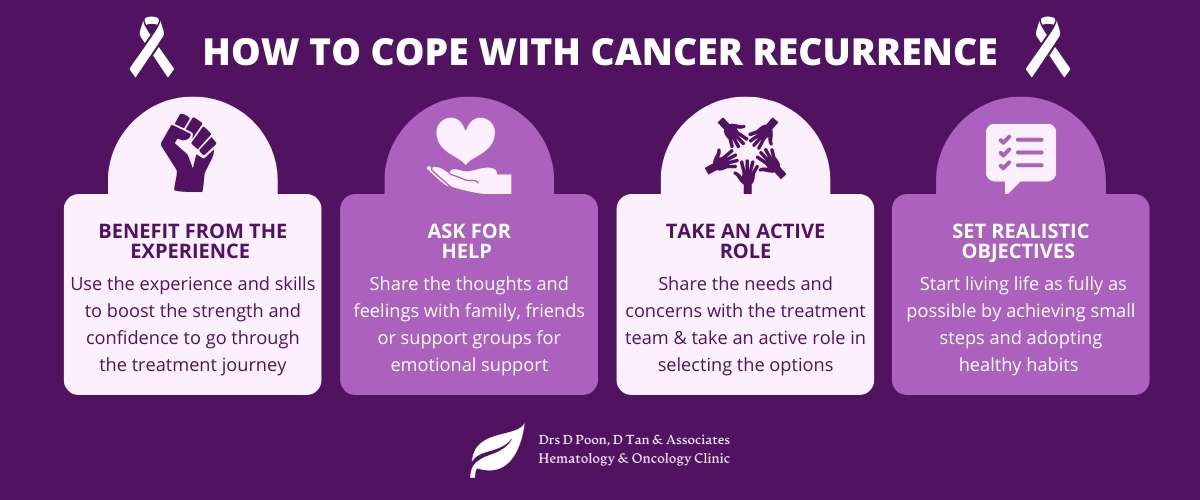
Cancer Recurrence – Does It Mean That All Hope Is Lost?
Table of Contents
- What is cancer relapse?
- Why does cancer relapse happen?
- Recurrence rates of different cancers
- Types of cancer recurrence
- Symptoms of cancer relapse
- Treatment for cancer that comes back
- How to prevent cancer recurrence
- How to cope with cancer recurrence
- Takeaway Message
After months of battling cancer and the gruelling side effects that come with the disease and its treatment, you are finally there. You were informed that you are in remission, which is to say that the signs and symptoms of cancer are no longer detectable. But you still have a lot of questions. Can doctors know for sure if all cancer cells have been eliminated? What is the chance of cancer coming back? How can we prevent it from returning? And if cancer recurs, does it mean that treatment did not work?
Indeed, the first remission might not be the end of the battle for many cancer patients. In this article, we discuss cancer recurrence, or cancer relapse. We will start by briefly defining cancer relapse, then discuss its causes, symptoms, treatments, and address the common questions above.
What is cancer relapse?
Cancer relapse, or cancer recurrence, describes the return of cancer after treatment has successfully cleared signs and symptoms of cancer in the patient – a status doctors call “cancer remission” or “no evidence of disease”. Note that relapse refers to the same type of cancer that was being treated. If a different type of cancer comes up, it is considered new cancer, not recurrence.
Getting the news of cancer relapse can trigger feelings of anger, shock, and sadness. But it is not hopeless. There are treatment options for cancer recurrence. And many patients have been able to turn a cancer relapse into remission again.
Looking at the bright side, patients with cancer recurrence have experience with the disease. Therefore, they know exactly what to expect. They can also count on the advances made in antineoplastic agents. Every year, new drugs get released to help patients with cancer. This means that the treatment you received when you were first diagnosed may have been improved. Among those new drugs are biological and targeted therapies which have dramatically less severe side effects.
Why does cancer relapse happen?
Cancer relapse happens generally because some cancer cells remain in the body despite treatment and preventive measures.
For instance, a cancer tumour is treated with surgery. In previous articles, we mentioned that surgeons often remove the peripheral tissue surrounding the tumour. Despite the healthy-looking aspect of this tissue, it is a necessary step known as the margin of security. The purpose of removing healthy-looking tissue is to prevent cancer recurrence. However, if a few cancer cells make their way beyond the margin of security, they could develop into a full-grown tumour again.
Similarly, for patients who undergo chemotherapy and radiotherapy, some cancer cells may manage to evade the treatment and detection, causing cancer recurrence afterward. For this reason, doctors may recommend adjuvant therapy as part of your treatment. Adjuvant treatment aims to reduce the chance of cancer recurrence. It may involve using chemotherapy or radiotherapy after a surgery to eliminate cancer cells that may have spread to outside the surgery site. Adjuvant therapy is often used for early-stage cancer.
With that said, this is not the only way that allows cancer to relapse. People with a medical history of cancer may develop cancer again. This is more common in individuals with genetic mutations, such as the P53 protein mutation which is present in many patients with colorectal cancer, head and neck cancer, small cell lung cancers, breast cancer, among others. Note that if a new tumour is of a different type, it is called second primary cancer and not cancer recurrence.
Recurrence rates of different cancers
The recurrence rates of cancer are extremely diverse. Some cancers rarely come back whereas others are notoriously known for their high recurrence rates. This does not affect cancer recurrence survival rates, however.
Here are the types of tumour with the highest recurrence rates:
Glioblastoma – This is the most common type of brain tumour. According to a study published in the Journal of Neuro-Oncology, glioblastomas have a recurrence rate of almost 100%.
Bladder cancer – Doctors often remove this cancer surgically. Its recurrence rate is 30-54% locally.
Epithelial ovarian cancer – According to a study published in Expert Review of Anticancer Therapy, this cancer has a recurrence rate of almost 85%.
Breast cancer of certain types and stages is also known for relapses. The vast majority of breast cancer recurrences happen within 5 years after treatment. Regardless of the treatment method you received, the risk of relapse remains relatively constant.
Types of cancer recurrence
Depending on the location of the tumour and how far it has spread, we could classify cancer recurrences into three types:
Local recurrence – The newly discovered cancer is in the same location or near the initial tumour.
Regional recurrence – The newly discovered cancer has spread to nearby tissues and lymph nodes.
Distant recurrence – The newly discovered cancer has spread to distant organs. We also refer to this process as metastasis. Note that the name of the cancer does not change even if it occurs elsewhere. For instance, lung cancer will still be called lung cancer even if the cells spread to the bone and form a tumour there.
Symptoms of cancer relapse
When your cancer treatment is complete, you need to undergo a number of tests and follow-up examinations to confirm the elimination of the tumour. During this phase, your doctors will look for any signs of remnant cancer cells.
If there are any signs of cancer on blood tests or imaging techniques, your doctor will order a biopsy to confirm the diagnosis. This will allow us to differentiate between a recurring tumour and a new cancer.
You should also be aware of any physical symptoms that may indicate the return of cancer. Of course, the signs and symptoms of cancer relapse vary dramatically depending on the type and location of the tumour. Look out for symptoms you experience when the cancer first showed up. Additionally, below are some common symptoms:
- Unexplained loss or gain of 5 kilograms or more
- Persistent cough or hoarseness
- Lumps or swelling
- Sores that don’t heal
- Night sweats
- Extreme fatigue
- Changes in bowel or urinary habits
- Bloody stools or urine
- Pain when urinating
- Problems with swallowing
- Abdominal pain
- Nausea
- Jaundice
Treatment for cancer that comes back
Just like the initial tumour, treating a recurrent cancer depends on its type, location, and whether or not it has spread. Another factor that influences treatment is how resistant the cancer is to chemotherapy.
For instance, if you have recently recovered from prostate cancer, serum prostate-specific antigen (PSA) may turn up elevated in one of the follow-up tests. At this point, your doctor may not opt for surgical or medical treatment. Instead, simple surveillance may suffice.
If the cancer spreads to other parts of the body, other treatments may be necessary.
These include:
- Surgery
- Chemotherapy
- Radiation therapy
- Hormone therapy
When your treatment is over, you may come across the terms ‘complete remission’ and ‘partial remission’.
- Complete remission – This indicates that follow-up tests show no detectable cancer in the body.
- Partial remission – The treatments limited the cancer but did not eliminate it.
One of the possible treatments for recurrent cancer is the participation in a clinical trial. These studies are continuously running to discover and test new treatments for cancer. However, clinical trials might have several inclusion and exclusion criteria. Speak with your physician about your eligibility to be part of these trials.
How to prevent cancer recurrence
Preventing cancer recurrence is not a sure thing. There is no guarantee that anything you do will prevent cancer at 100%.
However, eating right, exercising, and keeping track of your follow-up visits can be helpful in many ways. They may help with its early detection. Identifying cancer during its early stages is absolutely crucial to treating it efficiently. They also help you build your body reserve if a second round treatment is required.
In my practice, I have come across patients who blame themselves after cancer recurrence due to a variety of reasons, including:
- Neglecting the doctor’s visits
- Postponing important tests for a family vacation
- Eating an unhealthy diet
- Living a sedentary lifestyle
Please be reminded that doing everything right is necessary but does not guarantee the cancer will not come up. There are multiple modifiable and nonmodifiable risk factors in play here, the most important factor of which is perhaps the type of cancer you have.
To take glioblastomas as an example, it has an extremely high recurrence rate of almost 100%. In other words, regardless of what you do to prevent this cancer, it may still happen. It does not mean that monitoring and treatment are not useful. You can still rely on doctors, medication and care to improve your quality of life and make the most of your time. Speak with your primary care physician or oncologist about the best measures to lower the risk of recurrent cancer for your case.
How to cope with cancer recurrence
Benefit from your experience – Since you already have experience with cancer, you possess valuable knowledge on how to cope with it. Use that experience and skills to boost your strength and confidence as you go through the treatment journey.
Ask for help – Feeling angry and sad about this news is completely normal. Make sure to tell your family and friends that cancer will not change who you are. Ask them for emotional support without expressing pity. Support groups are also a good idea to share your thoughts and feelings.
Take an active role – Instead of accepting everything the doctors throw at you, take a more active role. This does not mean you should oppose good medical advice. It just means you should share your needs and concerns with your treatment team and take an active role in discussing and selecting the options on the table.
Set realistic objectives – Start living your life as fully as possible. This can be achieved with small steps. For instance, create a list of daily goals that you need to meet. Ensure the goals are not too difficult. Adopting healthy habits will allow you to live your life and prevent cancer recurrence from taking over your daily routine.

Takeaway Message
Cancer relapse is a devastating yet relatively common event for cancer patients. Despite the numerous advances we have made in medical oncology, cancer remains an insidious disease that sometimes can dodge the best treatment and surveillance and make an unwanted comeback.
Cancer relapse can be treated and many patients have survived recurrence. Learning about the risk of cancer recurrence and how to cope with this event is indispensable. It is crucial to discuss with your oncologist early on about the chance of recurrence and what adjuvant therapies are suitable for your case. Equally important is adhering to the follow-up schedule with your doctor, keeping a healthy lifestyle and positive mindset after remission has been achieved. As the saying goes, there is a ‘CAN’ in cancer.
Dr Donald Poon




